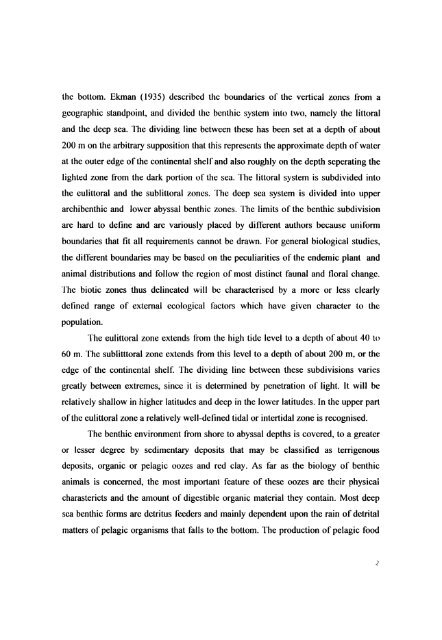L - Cochin University of Science and Technology
L - Cochin University of Science and Technology
L - Cochin University of Science and Technology
Create successful ePaper yourself
Turn your PDF publications into a flip-book with our unique Google optimized e-Paper software.
the bottom. Ekman (1935) described the boundaries <strong>of</strong> the vertical zones from a<br />
geographic st<strong>and</strong>point, <strong>and</strong> divided the benthic system into two, namely the littoral<br />
<strong>and</strong> the deep sea. The dividing line between these has been set at a depth <strong>of</strong> about<br />
200 m on the arbitrary supposition that this represents the approximate depth <strong>of</strong> water<br />
at the outer edge <strong>of</strong> the continental shelf <strong>and</strong> also roughly on the depth seperating the<br />
lighted zone from the dark portion <strong>of</strong> the sea. The littoral system is subdivided into<br />
the eulittoral <strong>and</strong> the sub littoral zones. The deep sea system is divided into upper<br />
archibenthic <strong>and</strong> lower abyssal benthic zones. The limits <strong>of</strong> the benthic subdivision<br />
are hard to define <strong>and</strong> are variously placed by different authors because uniform<br />
boundaries that fit all requirements cannot be drawn. For general biological studies,<br />
the different boundaries may be based on the peculiarities <strong>of</strong> the endemic plant <strong>and</strong><br />
animal distributions <strong>and</strong> follow the region <strong>of</strong> most distinct faunal <strong>and</strong> floral change.<br />
The biotic zones thus delineated will be characterised by a more or less clearly<br />
defined range <strong>of</strong> external ecological factors which have given character to the<br />
population.<br />
The eulittoral zone extends from the high tide level to a depth <strong>of</strong> about 40 to<br />
60 m. The sublitttoral zone extends from this level to a depth <strong>of</strong> about 200 m, or the<br />
edge <strong>of</strong> the continental shelf. The dividing line bctween these subdivisions varies<br />
greatly between extremes, since it is determined by penetration <strong>of</strong> light. It will be<br />
relatively shallow in higher latitudcs <strong>and</strong> deep in the lower latitudes. In the upper part<br />
<strong>of</strong> the eulittoral zone a relatively well-defined tidal or intertidal zone is recognised.<br />
The benthic environment from shore to abyssal depths is covered, to a greater<br />
or lesser degree by sedimentary deposits that may be classified as terrigenous<br />
deposits, organic or pelagic oozes <strong>and</strong> red clay. As far as the biology <strong>of</strong> benthic<br />
animals is concerned, the most important feature <strong>of</strong> these oozes are their physical<br />
charastericts <strong>and</strong> the amount <strong>of</strong> digestible organic material they contain. Most deep<br />
sea benthic forms are detritus feeders <strong>and</strong> mainly dependent upon the rain <strong>of</strong> detrital<br />
matters <strong>of</strong> pelagic organisms that falls to the bottom. The production <strong>of</strong> pelagic food<br />
2

















